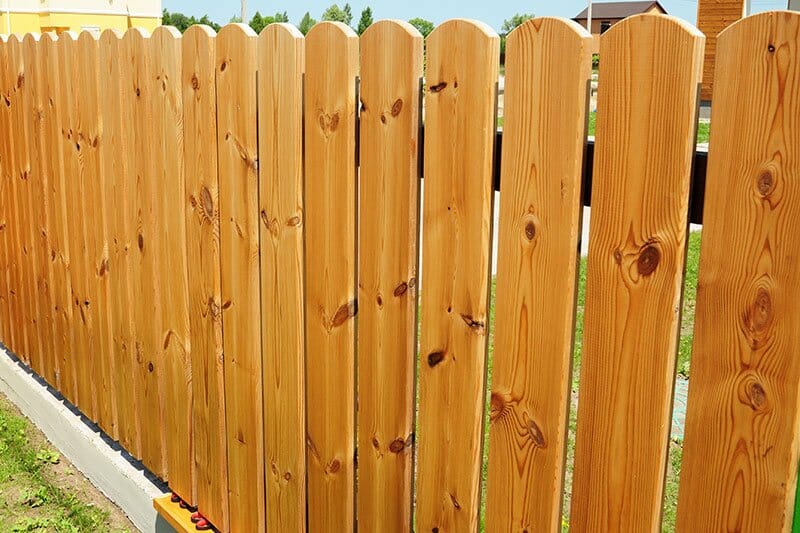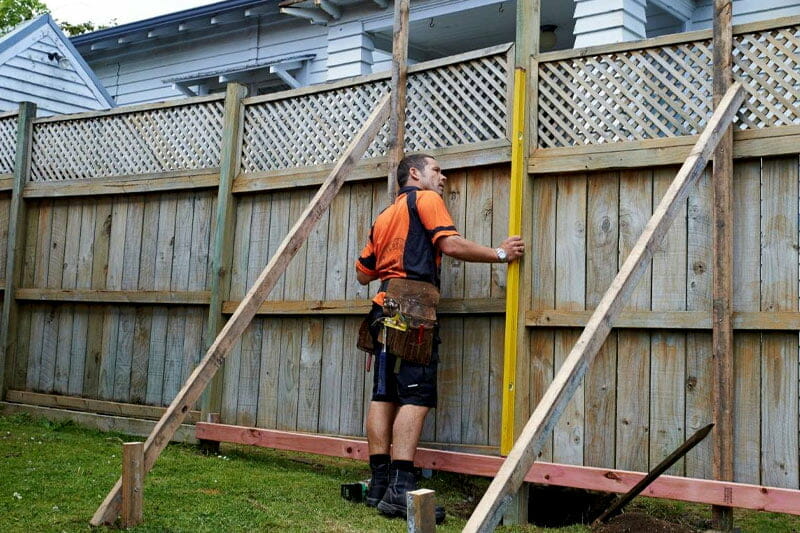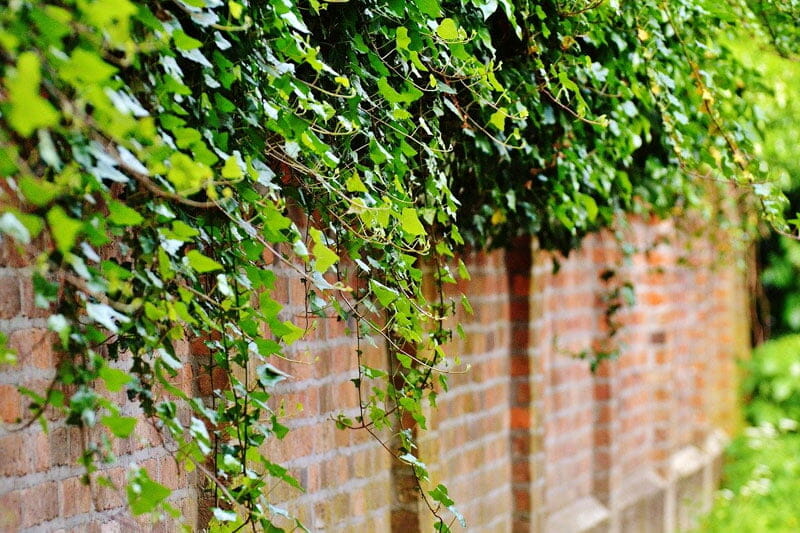The importance of the height of a fence should not be overlooked when aiming for a successful fencing project. Building codes, which vary by state, set the minimum height requirements for fences.
The standard fence height for residential properties ranges between 4 feet and 6 feet. Whereas commercial property fences can be as high as 10 or 12 feet. The standard height varies based on the nature of the fencing project, the fencing material used, the role of the fence, local building codes, and fence locations.
In this article, we highlight the standard fence heights based on their material and their role. We also put together a guide to help you choose the right height for your fence.

Factors That Determine The Standard Height Of Fence
The standard height of a fence is set by the state, city, or local code and is dependent on a handful of factors
Role Of The Fence
Each fence installed on a residential or commercial property serves a unique purpose, which influences the height of the fence.
Front Yard Fence
The standard height of a front yard fence is 3 feet. The fence is mostly for marking your territory as opposed to maintaining privacy. This height is ideal because it allows passersby to admire your home from the outside, and it also raises the home’s landscape design. A front yard fence that is three feet high also prevents pets and toddlers from leaving the compound while playing in the front yard.
Backyard Fence
In order to preserve curb appeal, the front yard fence is always shorter than the backyard fence. The general rule of thumb is that the standard height for a backyard fence should be anywhere between 6 to 8 feet. A moderately tall fence for the backyard is important to increase the security of the property.
Pool fence
The standard height for a pool fence is 4 to 5 feet. A five-foot fence is ideal because it is not too tall, neither is it too short. This height deters children from accessing the pool area unsupervised because adults can see what is going on in the pool area at all times.
Apart from having an ideal height for your pool fence, you can enhance safety around the pool by choosing a material that has the fence panels close together and doesn’t offer footholds or handholds. In this case, I recommend installing vinyl fencing around your pool.
Garden Fence
The garden fence is a somewhat short fence ranging between 3 to 4 feet. This type of fence keeps animals, such as rabbits away from your garden while still allowing you to see what is going on inside the garden. The fence height is also perfect for the garden owner to show off the hard work that they have put into their garden.
Boundary Fence
A standard boundary or partition fence is short. A three-foot fence is sufficient to demarcate your boundary because the fence’s main purpose is to prevent intruders from accessing your property.
Privacy Fence
The standard privacy fence is usually 6 to 9 feet tall. A privacy fence needs to be this tall and with panels completely connected to block outsiders from viewing the inside of your home.
Decorative Fence
A decorative fence is mostly used to enhance a home’s curb appeal, so scaling it higher than 4 feet would be irrelevant.
Commercial Fence
In industries or commercial buildings, fences can be as high as 8 to 10 feet. This height allows businesses to maintain their privacy, especially from their competitors and any potential burglars. Additional electric fences may also be included to bump up security.
Material Used In Constructing The Fence
Different fence materials have different standard heights based on their nature. Although these heights are standard, the material can be customized to any height you want.
Chain-link Fence
While the chain-link fence does not provide privacy, this strong and durable type of fence’s average height is 4 feet. The height is ideal for providing a barricade for any possible intruders into the compound. Before installing a chain-link fence, you must confirm that your local zoning laws allow this type of fencing because it’s not uncommon to find restrictions.
Wood Fence
Wood fences are possibly the oldest type of fencing, and their popularity has not reduced over the years. The standard height of wood fences is 6 feet, making it perfect for the backyard. A wood fence can be customized to any height, and you may also alter the height by adding a decorative border.
Vinyl Fence
Vinyl fence is among the most durable, versatile, and low-maintenance fencing alternatives present in the market currently. This type of fence has a recommended standard height ranging from 7 to 8 feet. The versatility of this fence allows it to be customized to a shorter version and used as a pool fence and front yard fence.
Wrought Iron Fence
Wrought iron is timeless and can be passed down from generation to generation, and the quality does not change. This luxurious, strong, durable, sophisticated, and high-end fence that can be used for more than a century has a standard height of 6 feet. When used for the front yard, the steel and iron metal give the property an elegant look and strong curb appeal.
What Is The Purpose Of Standard Height For Fences?
As seen above, the role and placement of the fences greatly dictate your boundary fence’s standard height. However, the main question is, why is there a standard height for fences?
Local regulations dictate the limit height for fences because:
As a Safety Precaution
Take a front yard fence as an example: a tall front yard fence causes a sightline for cars by creating blind spots, which can be a safety hazard for children and pets playing outside intersections. Shorter fences allow for visibility, reducing the possibility of accidents happening around blindspots created by too-tall fences.
Maintain Uniformity in the Area
Having different fence heights in one area may be unsightly since there is no uniformity in the area. This, however, does not apply if a home is located next to an industry or a commercial building.
Can You Build A Fence Taller Than The Standard Fence Height?
Yes. However, you will need to apply for a variance for a higher fence at the Local Building and Code Department, which should be submitted while submitting the fence application permit.
While filling out the application, you will be required to articulate why you want to build a taller fence. Getting this permit is quite the hustle because if the fence is a party fence, you will also need approval from your neighbors.
Simple Ways To Make Your Standard Fence Taller
Did you know you can extend the height of your standard height after installation? Yes, that’s true, and here are two popular ways to make your fence taller.
Add Trellis
This is the most popular way of extending the height of your fence. A trellis can be used as a fence topper because it is designed to sit on top of the current fence while still allowing light into the compound. Most of the fence toppers are 1 to 2 feet in height and 6 feet in length to fit the whole width.

Plant a Live Fence
Live fences are a popular alternative among homeowners because it gives your fence a natural and organic look with a nice smell while still providing shade and privacy to your compound.
Various plants can be used, such as vines and climbing plants, while you can add poles and wires to train the climbing plants.
You can also opt to grow a hedge along the fence for a taller and thicker fence, blurring external noise. A downside to this alternative is that hedges require quite a lot of maintenance, such as regular trimming and watering, and can take quite some time to reach the optimal height.

Consult A Professional
Before installing a fence, ensure you incorporate the services of a professional fence installer because fence installation is not a walk in the park and requires a lot of expertise.
More so, if you are going for a moderately tall fence, a quality fencing company will take you through all the legal formalities before the installation. Imagine investing in an expensive and durable fence such as wrought iron only to be bombarded by the authorities because of failing to adhere to the regulations, like the standard fence height.
We have a free tool that connects you to local professional fence installers in three easy steps.
- Scroll to the top of the page.
- Answer a few questions on your fencing project.
- Get matched with top-rated professionals within seconds.
Just like that, you will receive quotes from three companies, and you can pick either to install your fence. The best part? The tool and service can be used at your pleasure, and there’s no obligation to hire.







